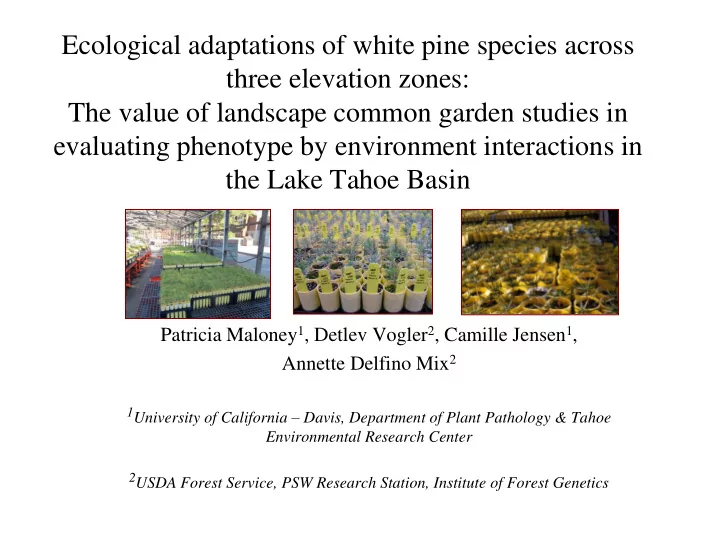

Ecological adaptations of white pine species across three elevation zones: The value of landscape common garden studies in evaluating phenotype by environment interactions in the Lake Tahoe Basin Patricia Maloney 1 , Detlev Vogler 2 , Camille Jensen 1 , Annette Delfino Mix 2 1 University of California – Davis, Department of Plant Pathology & Tahoe Environmental Research Center 2 USDA Forest Service, PSW Research Station, Institute of Forest Genetics
Common garden studies and phenotype x environment interactions Classic experiment by Clausen, Keck, and Heisy 1940 Potentilla glandulosa - 3 source elevations I. Seed are collected from many sources (families) II. Families are grown in a common environment Native to III. Measure a variety of adaptive traits IV. Determine relationships between traits and environment of the source locations Grown at
Landscape common garden studies for sugar pine, western white pine and whitebark pine
Results of genecological study of Sugar pine, Pinus lambertiana, from the Lake Tahoe Basin Premise of study • Examine phenotype by environment interactions • Determine landscape patterns of phenotypic variation and local adaptation
I. We collected seed from many sources (families) in the Lake Tahoe Basin • Collected cones/seed from 10 populations • 111 families from 8 source populations were grown in the common garden
II. Families are grown in a common environment
III. Measure a variety of adaptive traits
IV. Determine relationships between environment and source locations a. Climate (annual precipitation, Tmin, Tmax, May GDD, Aug GDD, elevation, % max solar radiation input) Maps courtesy of Woody Loftis, USDA NRCS
IV. Determine relationships between environment and source locations, cont’d b. Soil (soil type, soil properties: AWC 0-25, AWC 0-50, % sand, % silt, % clay, CEC, WC -1/3 bar, WC -15 bar) Maps courtesy of Woody Loftis, USDA NRCS
Trait – Height growth Variable HTINC -0.35 Elevation (m) -0.03 % max. rad. input 16 -0.01 Ann. ppt. (mm) 14 -0.36 Tmin ( o C) -0.05 12 Tmax ( o C) May GDD -0.08 10 Aug GDD -0.26 8 AWC 0-25 0.13 AWC 0-50 0.18 6 % sand -0.11 4 % silt -0.08 2 % clay -0.14 CEC 0.07 0 Tunnel Creek Glenbrook Heavenly Sandpit Bliss SP Sugar pine Point Granlibakken Carnelian Bay WC -1/3 bar 0.19 SP Source populations WC -15 bar 0.16
Trait – Bud flush (growth initiation) Variable BF -0.15 Elevation (m) -0.05 % max. rad. input 146 0.03 Ann. ppt. (mm) 144 -0.15 Tmin ( o C) 142 -0.12 Tmax ( o C) 140 May GDD -0.13 138 Aug GDD 0.09 136 AWC 0-25 -0.21 134 AWC 0-50 -0.21 132 % sand 0.16 130 % silt -0.16 128 % clay -0.15 126 CEC -0.14 124 Tunnel Creek Glenbrook Heavenly Sandpit Bliss SP Sugar Pine Point Granlibakken Carnelian Bay WC -1/3 bar 0.05 SP Source populations WC -15 bar -0.08
Trait – 13 C (water-use efficiency) -31.40 -31.20 -31.00 -30.80 -30.60 -30.40 -30.20 Tunnel Creek Glenbrook Heavenly Sandpit Bliss SP Sugar Pine Point Granlibakken Carnelian Bay SP Source populations
Influence of soil type on plant traits in the Lake Tahoe Basin Soil type Trait Andesite Granitic Mixed sources Volcanic Overall mean F -ratio P -value HTINC 12.65 11.03 12.20 9.79 11.25 4.35 0.006 BF 134.79 139.52 134.60 137.18 137.77 3.41 0.020 R:S 1.18 1.21 1.30 1.19 1.20 0.78 0.504 13C -31.13 -30.93 -30.79 -31.11 -31.00 5.23 0.001 15N 22.61 22.68 22.43 22.30 22.58 0.17 0.919 Map courtesy of Woody Loftis, USDA NRCS
Plant adaptation to drought involves both phenological and physiological traits Strategies include late bud flushing and less negative 13 C Phenology – Bud flush Physiology – Water-use efficiency Bud Flush (Julian day) 160 -34.50 155 -33.50 150 145 -32.50 13C 140 135 -31.50 130 -30.50 125 120 -29.50 Andesite Granite Mixed Volcanic Andesite Granite Mixed Volcanic sources sources
Drought adapted phenotypes and within – Basin seed transfer • Deploy drought adapted phenotypes (in some populations/stands) to mitigate the effects of a warming climate. • White pine restoration plantings will included a diversity of seedlings including WPBR-resistant and drought tolerant phenotypes. Map courtesy of Woody Loftis, USDA NRCS
Acknowledgements • Tom Burt for cone collections • Woody Loftis (USDA NRCS) for invaluable soil survey data and maps • Anne Liston • Jim Pollock • UCD – stable isotope facility • Funding sources: NVDSL Lake Tahoe License Plate Program & Southern Nevada Public Lands Management Act
Recommend
More recommend